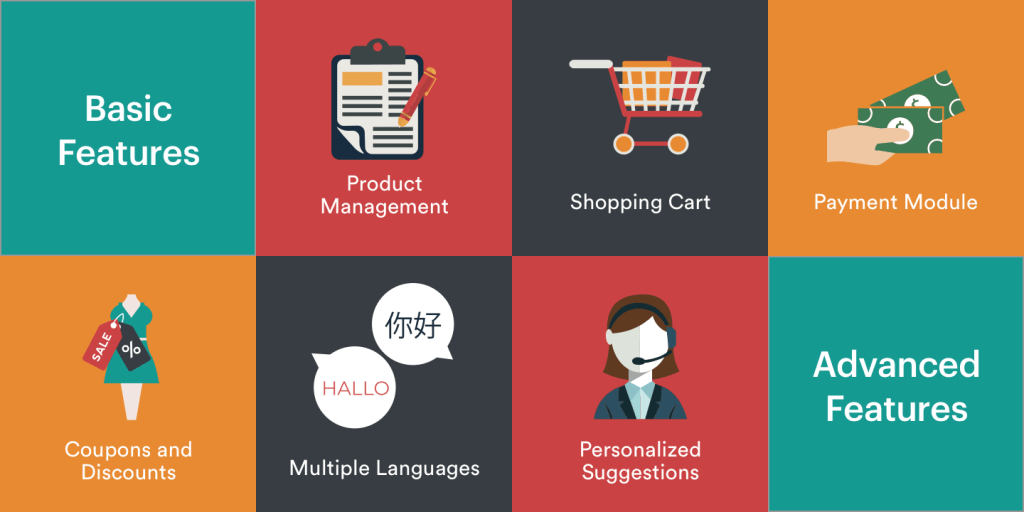The success of a website significantly depends on its design. If it is an e-commerce site, another factor can be the quality of its product; for a blog site, it can be how well the content is written; however, for a corporate site, it can be how well you express your brand identity.
Blog, Corporate, and E-commerce Website
An e-commerce website is a virtual store that allows clients to buy goods and services from the comfort of their own homes.
A corporate website is mainly about the brand name of a company. Your corporate website can influence people’s perceptions of your firm and business processes.
A blog is a frequently updated online page for personal or business content. Blogs are frequently participatory, with comment boxes at the bottom of individual blog postings where visitors can provide feedback.
Valuable features for a website
Content
For every website, accurate and well-communicated material is essential. In other words, utilize good grammar and ensure your writing is clear and precise. Furthermore, keep it brief and to the point! Please keep in mind that most web visitors have short attention spans.
An e-commerce site should have a product catalog, including information about products, their prices, and images. For a corporate website, it should be relevant to your brand. For a blog site, content should be relevant to your niche.
Distinct identity
It is critical to keep your identity evident and distinct. Choose one identity and try to incorporate it into every site facet. People will recognize and become more familiar with your brand if you communicate a consistent identity.
A business’s online and offline presence should align with a corporate site. Your writing style should be unique for a blog site, making it different from other blogs. For an e-commerce site, use customized logos, similar writing styles, and the best products to create a unique brand identity.
Easy-to-Use Navigation
Take time to examine your site and ensure everything is clear and easy to find. Clients should easily find what they are searching for on your website in seconds. Give your competitors no opportunity to outperform your website.
Allow customers to navigate either by brands or by category. For an e-commerce website, products should be categorized rationally, with the most popular categories listed first. For a blog site, the blogs should be published in reversed chronological order, making the latest blog appear first. It may allow the customer to navigate easily on a corporate site.
Site Search
Most of the leading websites provide a site search option. Customers can skip navigating your site and search for precisely what they want.
A site search on an e-commerce website can provide suggestions for famous brands and products that match what you enter. For a corporate website, it can help potential customers to look for a specific thing. A blog site may propose the most relevant blogs to your search and assist Google in crawling your site.
Social Media Inclusion
Numerous social networks are available, and you should promote your presence on your website, as social media is an essential component of promoting your business. Integrating these platforms into your website will assist in raising your SEO, improving your company’s social footprint, and growing your following across several social media.
The social media pages will connect customers to your brand, be it a corporate brand or e-commerce. However, social media presence might not affect your blog site significantly.
Visible contact information
Although it may appear simple, many businesses must provide contact information efficiently. Remember that visitors to your site do not find your contact information for over a few seconds. So, properly place your contact details. This is an essential feature for each website.
Customer Feedback
Testimonials are frequently highly compelling. Resist the impulse to invent your own, as savvy visitors will easily recognize them. Because most individuals rely on the opinions of others, testimonials can be employed as a genuine marketing tool.
A blog might include comments to allow customer feedback, allowing improvement. For a corporate or e-commerce site, it may suggest that the business is legit.
Unique Features of E-commerce Website
Wishlist
A buyer may be interested in a product but decide to purchase it later. Alternatively, a customer may find a product appealing and wish to investigate further. A wish list allows users to save a list of these products for easy access the next time they visit your website.
Customer login
Customers should be able to register and log in to your website. Customers can easily track their items thanks to the login functionality. Place it on the top bar for quick access.
Store Locator
If your e-commerce site contains physical stores or pick-up locations, a store locator in the top bar might help your customers find them. They may seek the feature to confirm information such as holiday closings, business hours, or other location-specific amenities.
Shopping cart
A shopping cart is a crucial component of any e-commerce site. This function acts as a bridge between the product page and the checkout process. The upper right corner is the most significant area to put it.
Reducers of risk
To entice potential buyers, provide a few good risk reducers, like free shipping and return incentives, because online customers have come to anticipate free shipping and returns as a given.
Loyalty Program
Mention things like loyalty points and other special deals for your regular consumers. Include a link to a more comprehensive offer page.
Icons for payment systems
Payment system icons are typically included at the bottom of the page. This informs your customers about the payment methods you offer.
Make the checkout process more straightforward.
Your customer’s path to purchase should be clear and straightforward. Experiment with different colors and typography to guide buyers through the purchasing cycle.
A cart view and a clear call-to-action (CTA) are other good ways to guide customers through the last phases of their trip.
Links to your company’s policies.
Inform clients about the operation of your store, including your web terms and rules. Simply having a return policy on your website can reduce shopping cart abandonment and alleviate customers’ fears of being trapped with a product they don’t need.
Endnote
You may miss out on increasing product recognition and elevating your digital brand if you do not have an effective e-commerce website. A well-designed website promotes product visibility, boosts store traffic, and gives a more personalized user experience.
We’ve offered you both necessary and desirable website features, but that does not indicate you should use them all. Begin by adhering to best practices and listening to your audience – prioritize the features that will provide the most value to them.
Experiment with different features to observe how they affect conversion, bounce rate, and the amount of social media shares your website receives. Remove elements that aren’t being used (since they may distract your user) and avoid anything that can irritate them and cause them to click away.






